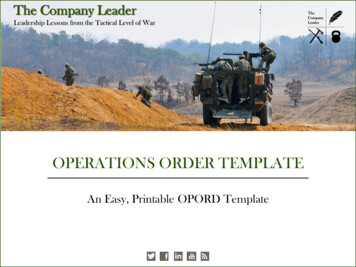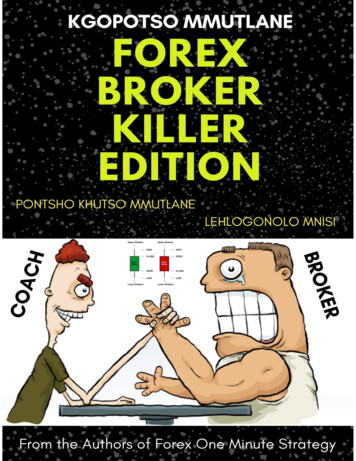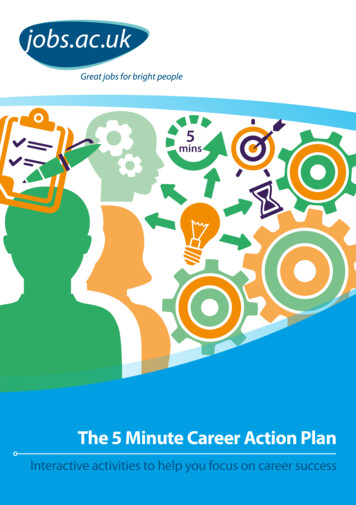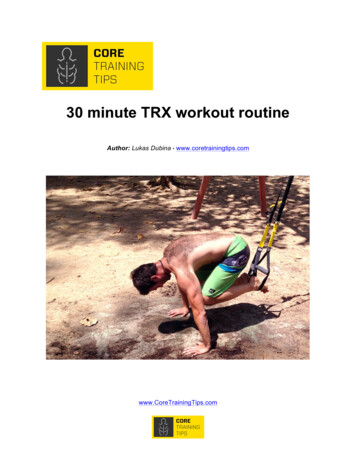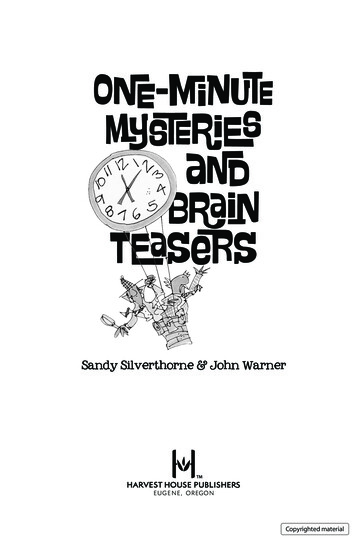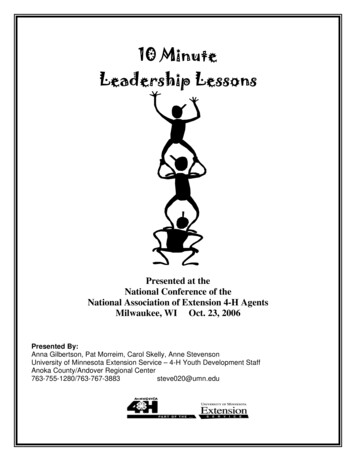
Transcription
10 MinuteLeadership LessonsPresented at theNational Conference of theNational Association of Extension 4-H AgentsMilwaukee, WI Oct. 23, 2006Presented By:Anna Gilbertson, Pat Morreim, Carol Skelly, Anne StevensonUniversity of Minnesota Extension Service – 4-H Youth Development StaffAnoka County/Andover Regional Center763-755-1280/763-767-3883steve020@umn.edu
We believe Leadership Skills and Concepts can be learned through fun, hands-on, experiential learning opportunities. In this workshop and handout, we have triedto identify many of these skills and to offer ideas and activities to help teach theseconcepts. 10 Minute Leadership Lessons are fun, thought-provoking experiences that canlead to stimulating discussions, meaningful insights, and significant learning forparticipants. These lessons can be used to on their own or as part of a larger experience.They will help participants understand, internalize, and utilize a wide array of importantleadership concepts, skills, and ideas.Experiential Learning at a Glance –Pages 2-4Leadership Skills: Index of ActivitiesUnderstanding Yourself/Your Traits Who’s At Your Table How I Rank Myself in Qualities of Being a LeaderGetting to Know Each Other Knee to Knee Pride LinesTeam Building/Group Process Alphabet Dancing Musical Paper Bags 10 Body Parts In This Group Evolution Rock/Paper/Scissors Who’s the Leader?Communication/Goal Setting & Planning When Somebody Claps Twice Pretzel Building Activity 8 W’s of Project Planning Perceptions ExerciseProblem Solving/Decision Making Marvin’s Mystery Jelly Bean Jar Checkerboard Challenge Wind Bags Red Card/Black Card GameAspects of Leadership/Leadership Analogies Color Symphony of Leadership OoglyResources2
Experiential Learning Model1EXPERIENCEthe activity;perform, do it52APPLYWhat was learnedto a similar ordifferent situation;practiceSHAREthe results,reactions, o connect theexperience toreal-worldexamplesPROCESSby discussing,looking at theexperience;analyze, reflectExperiential Learning Model adapted from Pfeiffer, J.W. and Jones, J.E. (1985). The Reference Guide toHandbooks and Annuals, Vol. 1-10, 1972-1985. San Diego, CA: University Associates Publishers andConsultants.3
Facilitating Experiential Learning Experiences OR“Turning the ‘Ha Ha!’ Into an ‘Aha!’”What is Experiential Learning?Experiential learning takes place when people are involved in a project or activity (DO),they look back at their experience critically (REFLECT), they determine what was usefulor important to remember and then use this information in real life situations (APPLY).(John Dewey).As a supportive adult you can help this process by:1. Setting aside enough time for reflecting on the experience.2. Asking the right questions and listening carefully.Experience- Do ItThis is the action step. Participants do it without being told or shown how to do it.Leaders need to “sit on their hands” or close their mouths so that participants canexperience and discover.Share- What Happened?Leader helps ensure that participants have a chance to talk and are listened to.Possible Questions: What did you do?What was happening?What was most fun?How did you feel?What did you notice about how the group worked?What was easiest?What surprised you?Process - What?Process by discussing, looking at the experience; analyze and reflect.Possible Questions How did you make your decisions? Did you help each other? How? Did people play different roles in this activity? (e.g. did someone act as theleader?) How did you communicate? Was anyone frustrated? What did you do? What was the most challenging part of this activity? Why? How did you solveit?4
Generalize – So What?Participants try to identify how to use what they’ve learned in their ownlives.Possible Questions: How does this activity or discussion relate to “real life?” Why do you think we asked you to do this activity? Have you had a similar experience in school, your club, etc.? Where have you faced similar challenges? Where might this situation occur in the future? Why is it important to have plenty of information before making decisions? What did you learn about your skills or style? What did you learn about your own skill in communicating with others? Did you make any mistakes that you can learn from?Apply – Now What?Facilitator helps them think about how they could use their skills in newsituations and apply generalizations they’ve made to specific situations.Possible Questions: What have you learned about yourself? Others? What principles or guidelines can be used in real-life situations? What other situations like this have you experienced before? In what ways do people help each other learn new things? How will you act differently in the future as a result of this experience? What are qualities that you think are important in a leader?5
Activity: Who’s At Your Table?Supplies Needed:Who’s at Your Table handout, pens or pencilsDirections:1. Begin with a brief discussion about how leaders need good role models/mentors.Discuss how just as a company or a large organization has a Board of Directors to helplead and guide it, so too do we all need to surround ourselves with people who can helpus on our leadership journey.2. Ask participants to use the diagram to create their own Board or Directors or their tableof mentors/role models. These may be people living or dead (or even non-humans—oneyoung man had his dog at his table because from the dog he learned unconditional love).They may be people the participant knows personally or just looks up to, people inhistory, etc.Follow Up:If time is limited, this exercise is useful just as an individual activity, with a brief followup discussion of why participants might want to keep this somewhere visible to remindthem of the support and guidance their table offers.If time permits, it is wonderful to have participants share who’s at their table and why.I also like to talk about how the people at your table can change, depending on where youare at in your life and your leadership journey, and how some people may always bethere. You can also talk about who’s table YOU might be sitting as, serving as theirmentor or role model. Especially with youth groups, I like to talk about how youngeryouth look up to them and what responsibilities that carries.6
7
How I Rank Myself In Qualities Of Being A LeaderI definitelyhave thisquality1. Enthusiasm: I have energy,a positive attitude, and am motivated.2. Prepared: I assess the situation,understand the audience, know howto prepare, how to report3. Communicate well with others:effective speaker, able to work withall kinds of people, tactful, goodlistener.4. Caring: I am sensitive to others, Iaccept others for who they are,compassionate, good sense of humor.5. Creativity: I can express ideas,can come up with helpfulsuggestions, I try to brainstorm fornew ideas.6. Problem-Solver: I can tackleproblems, am resourceful, I thinkthrough difficulties.7. Character: I act in an ethicalmanner; honest, not led astray bypeer pressure.8. Adaptability: can cope withunexpected, can accept change.9. Dependability: I am reliable,others can trust me, I make good onmy promises. Keep on task.10. Cooperation: work well withothers (even those I may not like).8I’m prettygood at thisI need towork on thisI need helpin how to dothis
Knee to Knee -- A Get Acquainted ActivityDirections: Line up 2 rows of chairs facing each other. Participants sit in the chair sothey are “knee to knee” with a partner (actually about 1 foot apart). Leader explains thisis a get acquainted activity. What participants will do is introduce themselves to eachother and then answer the question you ask. Each person has approx. 1 min. to answerthe question. (I usually direct them to shake hands and introduce themselves because Ithink shaking hands is a nice way to connect and is also a life skill).When time is up, ask participants to stand up and move X seats to the left (or right).Persons on the end rotate around to the other end of their line. Always have people movethe same direction for each switch, otherwise you end up with people getting back to apartner they’ve had before. They then introduce themselves to their new partner andanswer a new question you give them. Play as long as you like or as time allows.Usually 5 or 6 questions is a good amount.Questions 1.2.3.4.5.6.7.Tell about a favorite vacation you’ve taken.If you were a vending machine, what would you dispense?Tell about your favorite way to relax.Something that always makes you laugh when you think about it.If you could invent something, what would you invent?Tell about a favorite toy/game you had as a child.If you could win an award or prize for something, what would you like to win itfor?8. Tell about the first job you ever had.9. What is one thing you want to accomplish this year?10. If you were a hot air balloon, where would you go?11. If you won 1000 on a call in radio contest today, what would you do with themoney?12. Tell about a favorite book you’ve read.13. Tell about your favorite thing to do in your free time.14. Other questions can also be used.9
Pride LinesThese Pride Lines can be used in one to one conversation or in a group. Ask the child orchildren “How would you finish this sentence?”--then listen. You can also cut them apartand have students pick one and share their response with the group.1. I am proud that on my own I can.2. I am proud that I spent my allowance on.3. I am proud that when I am scared I.4. I am proud that I made a friend happy by.5. I am proud that even when the other kids did. I .6. I am proud that this summer I.7. Something that my family has done together this year that made me proud.8. I am proud that I use my toys.9. I am proud of what I did about.10. I am proud when the other kids say that.11. I am proud that I keep healthy by.12. I’m proud that I helped make my school a happier place by.13. I’m proud that my mother/father.14. I’m proud that I learned a new skill when.15. Something I worked hard for is.16. Something I own that I’m really proud of is.17. A habit I have that I’m really proud of.18. Something I really like about myself is.19. Something I’ve done for my family that I’m proud of is.20. Something I’ve done for someone else that I’m proud of is.Developed by Anne Stevenson, Extension Educator,Univ. of Minn. Extension Service10
Alphabet DancingPurpose: Good exercisein healthy competitionand organization.Works well in helping agroup of strangers get toknow one another.Group Size: 20-40Time: 10 minutesSupplies: Two sets ofindex cards with capitalletters of the alphabetwritten on each (oneletter per card for a totalof 52 cards).Directions:1. Divide the group into two teams.2. Arrange a set of alphabet cards on each of two chairsor tables that are set fifteen to twenty feet away fromtwo starting lines.3. Direct each team to stand behind one of the startinglines.4. Have your list of words ready (use suggestionsbelow) and when you call out a word, each team mustsend a player for each letter of the word to the stackof cards. They must find the correct letters and holdthem up in the proper order so that you can read theword. For instance, if you say CAT, three peoplemust run to the letters, grab one C, one A, and one T.Then they must arrange themselves in order, and holdup the cards so that you can read the word CAT.5. The team who spells the word correctly first gets apoint. After the word is spelled, the letters should bereturned to the stack. You can play until one teamhas earned a designated number of points, or untilyou’re exhausted your list of words. Whoever has themost points at that time wins.6. Sometimes it’s good to have tow referees watchingthe competition, and they can rule on who completedthe spelling first.7. Suggested words to use:dreamsoutlawNew Yorkharmonicgoalslistenangelssymbolicdriveway quietlythunderrhymechemistry bluecampmagicsimplepridemusicpartyflamingo fair8. With just the 26 letters of the alphabet, you arelimited to words with no duplicate letters. If youwant to add another E,T,S,R,A or L to the set ofletters, you can spell many more words.From: Getting Started: 100 Icebreakers for Youth Gatherings 2000Author: Patty Hupfer Riedel ISBN 0-937997-59-511
Musical Paper BagsThis is a great way for people to use their communication/teamworkskills as well as have some laughs.Supplies needed:Brown grocery paper bagsMusicSet up:Place the paper bags on the floor around the room.Here is the challenge:To successfully get ALL participants balanced on the paper bags. Participants are told that when the music starts, they are to mingle around, dance ifthey wish. The goal of this activity is about working as a team to ensure everyonegets on a bag! It is not like Survivor! When the music stops, each person has to have both feet on a paper bag. Tell themyou will countdown 3-2-1 after the music stops and they must have everyone on abag when you get to “1” When the music starts again, 1 or 2 paper bags are removed. Participants walk around again to the music and repeat the process. (Just likemusical chairs.)Watch what happens:As bags are removed, you will see people work harder to get everyone on.There usually is some clever person in each group that says, “hey can we rip the bag tomake it bigger? Or rip it in small pieces so that each person can stand on a piece?”Respond by saying, “We never said you couldn’t.”Sometimes the group has 1 bag left and is struggling to figure out a solution. If needed,you can give them a hint such as asking: ”Is there any way you can think of to increasethe space on the bag?” or “Can you think of any way to spread out the people but stillhave everyone touching a bag?”Reflection Questions: What was easy, what was hard about this challenge?How did people help or encourage each other?How did you work as a team?Did someone take on a leadership role or was there shared leadership?12
Activity: 10 Body PartsTask: Name 10 body parts that have only 3 letters in their spelling.Directions: Ask participants to use paper and pen/pencil and individually try to name 10body parts that have only 3 letters in their spelling. After 2 minutes, if desired, have thempair up with the person next to them and see if they can think of more. If time does notallow, simply ask the entire group the parts they came up with.Follow Up Discussion: You may hear others say “That’s not fair!” or “that’s not a bodypart!” or other comments as participants share their answers. They may ask you “Doesthat count?” as though they are in the running for a fabulous prize if they come up withmore than the others do I like to talk about how sometimes we create rules or boxes for ourselves that no one hasplaced on us limiting our creativity or our ability to solve problems. For example, afellow participant stated one of their body parts was “fat.” Some argued that’s not a bodypart, others argued fat is a big part of their body!Often, as participants share responses, others will say “Arrgh! I never thought of thatone!!” I like to talk about how many of us know more than we use at times Leadershipis about learning learning from others and from our experiences.13
In This Group You can cut apart each set of 6 questions, 1 per group member. A simple tool to use tohelp groups assess their interactions and working styles/challenges. It works best ifparticipants write their answers before beginning discussion.The thing I like most about this group is The thing I like least about this group is One thing I’d really like to see us accomplish this year is As a group, we need One thing I would like to change about this group is One thing I would personally like to get out of being involved in this group is .The thing I like most about this group is The thing I like least about this group is One thing I’d really like to see us accomplish this year is As a group, we need One thing I would like to change about this group is One thing I would personally like to get out of being involved in this group is .The thing I like most about this group is The thing I like least about this group is One thing I’d really like to see us accomplish this year is As a group, we need One thing I would like to change about this group is One thing I would personally like to get out of being involved in this group is .14
EVOLUTION Rock/Scissors/PaperAKA Superhero R/S/PEveryone begins as an amoeba. You are trying to evolve into a Superhero.Find one person and play Rock/Scissors/Paper.If you win, you go up (evolve). If you lose, you go down (de-evolve).If you tie, you stay the same.You must learn the motions/walk of the creatures:Amoeba:Egg:Dinosaur:Human:Superhero:walk crouched down and wiggling like an amoebawalk with arms overhead in an egg shapeStomp walkHands behind back-bouncy walkArms out to fly around!Processing: This game is mostly just for fun, but interesting questions often arise Do superheroes have an obligation to keep playing in order to help others evolve? Orshould they just quit when they become a superhero?Do Superheroes battle each other to become the only superhero? Or is the world betterthe more superheroes we have? How long does it take for everyone to become asuperhero?Variations: A participant suggested you could easily adapt this game to fit specificsubject or project areas, such as the life cycle of a frog or evolving up (or down) the foodpyramid. Use your imagination!15
Who’s the Leader?Directions:1. Participants stand in a circle.2. One person is asked to leave the room. It will be their task to figure outwho the leader is upon re-entering the room.3. 1 person volunteers to be the leader. The leader will initiate an action(such as clapping their hands, tapping their head, patting their knees, etc.)and the rest of the group mimics the action. The leader will changeactions- and when he/she does, the rest of the group mimics the newaction. The challenge for the group is to try to observe the leader andchange actions in a subtle way, so that the “outsider” cannot figure outwho the leader is.4. Continue the action until the “outsider” guesses who the leader is (theycan have 3 guesses!), or tell them who it is if they cannot guess correctly.5. Repeat with a new “outsider” and a new leader. Continue for several“rounds.”Discussion Questions: Did you enjoy this game? Why or why not? What was easy or hard about this game? Ask the “outsiders”: What made it hard or easy to figure out who the leaderwas? Did you have any strategies for figuring out who the leaderwas? What did you notice about the leader(s)? Did they have differentstyles or methods of leading? What skills did the leaders need to be successful? What was it like to be a follower? What skills did the followersneed? What aspects of this game can you take and apply to real lifeexperiences of being a leader or a follower? Have you ever had to lead a group of people to accomplish a task? Tell about a time when you had to follow someone. What made it apositive or negative experience?16
When Somebody Claps Twice - DirectionsIntroduction: Setting and working toward goals Is critical to the success of any group. Eachmember plays a part in the attainment of the goal. This activity gives participants the opportunityto work together toward a goal that benefits everyone.Objective: For participants to experience, in a concrete way, how all group members play a rolein reaching a goal, and to consider how groups set and attain goals.Time Required: Approximately 15-20 minutes.Procedure:1. Prior to the activity, facilitator needs to: a.) Buy enough candy (e.g. snack size candy bars orother pieces of individually wrapped candy) for the number of participants in the group. Thisshould be placed at the front of the room. b.) Cut apart the statements into small slips of paper.You must have one per person; if you have a smaller group participants can receive two slips ofpaper.2. The activity works best when all group members can see each other easily. Facilitator explainsto the group that they will be working together to achieve a goal, which is everyone receiving apiece of candy. To do this, each person will have to do his/her part to reach the goal.3. Hand out the slips of paper to participants. After giving them a moment to read their paper, thefacilitator claps twice. This should start the action rolling, and if everyone does his/her part,everyone ends up with a piece of candy!4. Very often, the action stops, either because someone isn’t paying attention, or they miss theclue of the person before. Sometimes a person “jumps in” when they’re not supposed to, causingthe movement to stop or to “skip” some people. If this happens, ask everyone to check his or herpaper, then start over by clapping twice.Processing1. Talk about what happened: Was it easy to reach the goal? What things hindered you fromreaching the goal? What did you do that helped you reach the goal?2. Talk about the goal: Was it a worthwhile goal? Even though you didn’t decide on the goal,you were willing to work toward it. Have you ever had to work for a goal that you didn’tchoose? What’s it like to work for a goal that you don’t feel is worthwhile? What’s it like towork toward a goal in which there isn’t an immediate “reward,” or one which takes a longtime to accomplish?3. Talk about goal setting in your group. Does our group have specific goals? Does everyone inthe group know what they are? What do we do if people don’t “buy in?”Source: Developed by Patty Hupfer and Anne Stevenson for the Wisconsin Association of SchoolCouncils, Inc. Summer Leadership Workshop17
WHEN SOMEBODY CLAPS TWICEWhen somebody claps twice, stand up and say “good morning”.When somebody says “good morning”, get up and turn off the lights.When somebody turns off the lights, yell “It’s dark in here!”When somebody yells “It’s dark in here!” get up and turn on the lights.When somebody turns on the lights, stand up and spin around twice.When somebody spins around twice, make a loud cow (mooing) noise.When somebody makes a cow (mooing) noise, stand up and say, “I’m gladto be here!”When somebody says “I’m glad to be here,” stand up and flap your arms likea bird.When somebody flaps their arms like a bird, stand on your chair.When somebody stands on a chair, say “Get down from there!”When somebody says ‘Get down from there!”, make a loud sneezing sound.When somebody makes a loud sneezing sound, feel the forehead of theperson next to you and shout “Somebody get a Doctor!”.When somebody shouts “Somebody get a Doctor!”, “Mary Had a LittleLamb” in a loud voice.When somebody sings “Mary Had a Little Lamb,” walk around theleader/teacher 2 times.When somebody walks around the leader/teacher two times, laugh reallyloud.When somebody laughs really loud, stomp your feet for 5 seconds.18
When somebody stomps their feet, do a cheerleading move and say “Rah!Rah! Rah!”When somebody does a cheerleading move and says “Rah! Rah! Rah!”, tellus what time it is in a loud voice.When somebody tells us what time it is, shake hands with the person next toyou and loudly say, “Nice to meet you!”When somebody says “Nice to meet you!”, say “I have a question”.When somebody says “ I have a question”, yell: “The answer is seven.”When somebody says “The answer is seven,” go to the front of the roomand make the letter Y with your body. Yell out “Y” and stay there.When somebody makes the letter Y, grab 2 other people, go to the front ofthe room, stand next to the Y and make the letters M, C, and A, then sing“YMCA.”When somebody sings “YMCA”, hop on one foot for 5 seconds and yell “Iam a rabbit.”When somebody says “I am a rabbit,” say “Here comes Peter Cottontail!”.When somebody says “Here comes Peter Cottontail!” give everybody apiece of candy!19
Pretzel ActivityOne way, two way communicationSupplies you will need:Pretzel sticks (skinny, small ones)Paper TowelsActivity:Pair up with another person and sit back to back. Place a paper towel down flat in frontof each person. Give each person 10-15 pretzels.The pair decides who will be the communicator and who will be the receiver. Thecommunicator will go first and make a design/shape on their paper towel.They will then explain their design/shape one pretzel stick at a time. Example: “I placedmy first pretzel stick vertical in the middle of the towel.”The receiver of the information cannot ask any questions to clarify the instructions theyare receiving.Once the activity is completed, look and see how well they match.Now it is time to switch roles. The receiver now becomes the communicator, but thistime the receiver CAN clarify and ask questions.Reflection Questions:What was it like to follow directions and not be able to ask questions?Did you find yourself getting frustrated?Discuss what it was like to be able to talk?Why was this easier?Which is better one-way, or two-way communication? Why?20
Planning an ActivityThe 8 W’s1. WHAT are you planning to do?2. WHY do you want to do this project? WHO willbenefit?3. WHEN and WHERE will the activity take place?Date: Time: Location:4. WHO needs to approve the project?5. WHAT funds are needed to do this activity?6. WHAT kind of publicity is needed? WHEN?Type of publicityWhen needed?7. WHO will do the WORK?TaskPerson Responsible21Date Due
8. We’re Done!! Was it Worthwhile?What went well?What didn’t work so well?What would you do differently next time?Who needs to receiveNamea thank you note?Who will write it?22
Perceptions ExerciseEach person perceives life in a unique way. How people act or react is affected bytheir perspective, life experiences, personal history, etc. To be an effective leader, or tobe successful in “customer service,” we need to be aware of these factors.Time Required: Approx. 20-30 minutesActivity:Leader: Tell participants you are going to give them 5 scenarios and then ask for theirresponse to a question about that scenario. Remind them this is solely asking for theirreaction, so it is important not to ask their neighbor for input-they should go with theirfirst reaction to the question. (I sometimes ask them to number their paper 1-5).Perception Scenarios and questions:1. Your neighbor bought an expensive car. How much did it cost?2. Your car has some problems and you have to take it in to the mechanic. Themechanic says: “This will take awhile.” How long will it be?3. Someone calls you with a question and you tell them, “You will hear from mesoon.” (or “I’ll get back to you soon.”). When will that be?4. You went to return some merchandise at a store. There were too many peoplestanding in line. How many people is that?5. A kid at your summer program/camp asks you when you will play a certaingame. You tell him: “We’re going to do that activity later.” When will that be?Process: After going through the questions, go through each one as a group to see whatthe range of answers is for each question.E.g. Question 1: Someone might say 10,000, someone might say 80,000,and anywhere in between. List on a board or flip chart paper the range ofresponses. Lead some discussion about why the answers have such a wide range, what“personal history” people bring to their responses, and have participants talkabout how perceptions may affect someone’s frustration level with “customerservice,” or how your response can affect their perceptions of yourorganization or program. Discuss ways to improve upon communication. As always, tie this exercise in to your audiences’ particular program and“customers,” be they youth program participants, adult volunteers, generalpublic, or any other group.For further information on customer service and perception, refer to the source of this activity.Source: “At Your Service-Working with Multicultural Customers,” University of MinnesotaExtension Service, 200423
Marvin’s Mystery(A GREAT activity for Elementary aged children!)The group plays sleuth as everyone shares clues about Marvin the Magnificent.Materials and Preparation: Write on the board or give each player a handout with the following information:What’s missingA new kittenAn opera ticketA hair pieceA red convertibleA favorite cookie recipeA diamond earringWho took it?Ruffles, his dogSam Slick, his trainerLisa LaRue, his girlfriendHarry Armpits, his arch rivalAunt Lizzie, his favorite auntWhere is it?At the bottom of the lakeUnder the bedIn the washUp in a treeIn his soupWrite each of these clues on a slip of paper Marvin likes only Big Band music. Marvin is allergic to cats. Marvin is bald. Marvin doesn’t own a car. Marvin can’t cook. Marvin’s only piece of jewelry is a ring. Sam Slick’s in bed with the flu. Lisa LaRue is out of town making her first movie, “Computerbase.” Harry Armpits is completely innocent. Aunt Lizzie is on a safari in Africa. Marvin never eats soup. There are no trees around Marvin’s apartment. Ruffles likes to play under Marvin’s bed. It’s not in water. Marvin loves animals. Sam Slick regularly attends the opera. Harry Armpits loves to make homemade cookies. Lisa LaRue loves diamonds. Harry Armpits often goes fishing1. Read this aloud to the players:Marvin the Magnificent, world famous weight lifter, is very upset.In fact, he’s so upset, he’s refused to appear at a guest performance this eveningwith Harry Armpits, his arch rival. Marvin says, “I can’t go on until it’s found!”2. Explain that the challenge is to solve Marvin’s mystery as a group by sharing cluesand piecing together the evidence. They begin by reading about their clues,discussing them, and then figuring out as a group what Marvin is missing, who tookit, and where it is.24
There are only two rules:Don’t write anything down or mark your paper in any way.Don’t let anyone see your clue.3.
May 10, 2015 · We believe Leadership Skills and Concepts can be learned through fun, hands- on, experiential learning opportunities. In this workshop and handout, we have tried to identify many of these skills and to offer ideas and activities to help teach these concepts. 10 Minute Leadership
